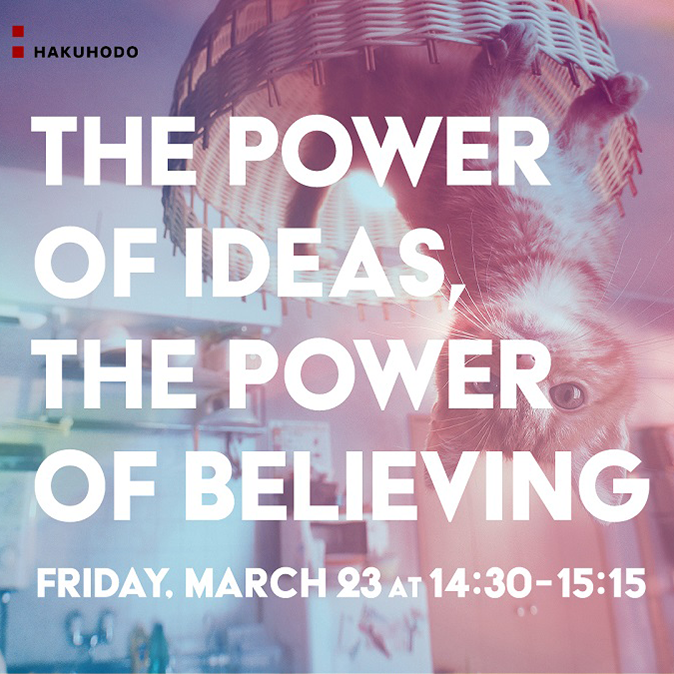- Events
ADFEST 2018, the 21st iteration of this Asia-Pacific advertising festival, was held March 21–24 in Pattaya, Thailand. Hakuhodo hosted a seminar featuring four Hakuhodo Group speakers on March 23. With Hakuhodo APAC Co-CCO Kentaro Kimura moderating, the first half of the seminar saw Yuta Okuyama of SIX Inc. discuss production secrets of the multi-award-winning film Gravity Cat. In the second half, monom team leader Naoki Ono and creative producer Ai Suzuki revealed the untold story behind Pechat, an app-operated speaker that enables a child’s favorite stuffed toy to “talk.” Link to Part 1
Topic: The Power of Ideas, the Power of Believing
Time: 2:30–3:15 p.m., Friday, March 23, 2018
Speakers:
Kentaro Kimura, APAC Co-Chief Creative Officer, Hakuhodo Inc.; Co-Chief Executive Officer, Hakuhodo Kettle Inc.
Yuta Okuyama, Creative Director, SIX Inc.
Naoki Ono, Leader, monom; Copywriter/Product Designer, Hakuhodo Inc.
Ai Suzuki, Creative Producer, monom, Hakuhodo Inc.
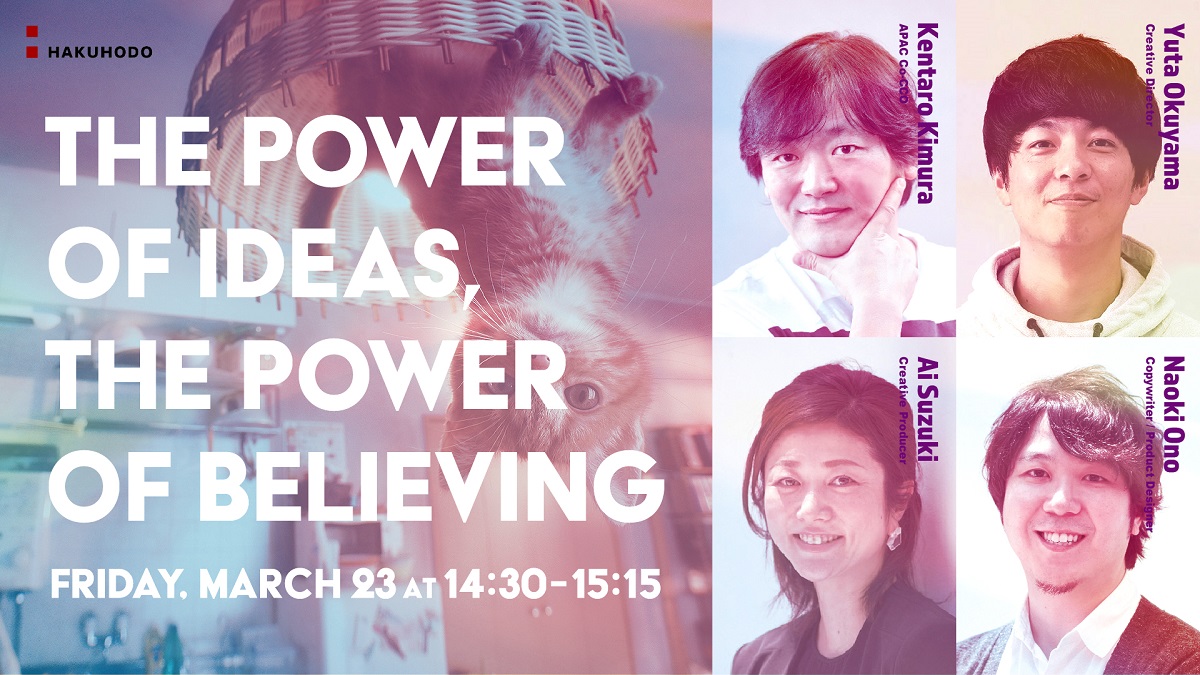
Here are excerpts from the seminar.
—————————————————————————
KIMURA: Pechat was launched by Hakuhodo in 2016, and now it’s a big, big hit in Japan. Let’s take a look at what it’s all about.
https://www.youtube.com/watch?v=RgNybn9456A&feature=youtu.be
I have three main questions to ask the two members of the development team about it:
1) Why did you do it in the first place?
2) How did you make it happen?
3) What’s the difference between advertising and product development?
1. Why it was produced
KIMURA: Hakuhodo is an ad agency, right? Why did you create and market such a product?
ONO: Originally I was—and still am—a copywriter creating ads. But I’m also a product designer outside our agency, making furniture and lighting products. And I thought, “why not combine the skills of a copywriter and product designer to do something exciting?” That’s how I started a product development team at Hakuhodo called monom.
KIMURA: You’d already been developing products for clients, hadn’t you? What was different this time?
SUZUKI: With “typical” client work, we’d suggest ideas and concepts for products, then leave the rest for clients to do. But at monom, we don’t stop at the concept; we actually go as far as creating the products ourselves. We also invest in it as a business.
ONO: Right. We believe that we can expand the potential of an ad agency by leveraging its creativity. It goes something like this.
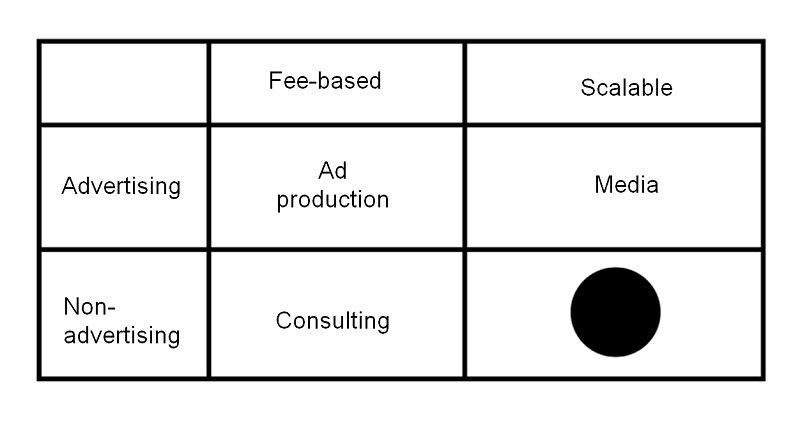
Our challenge is to fill in the lower-right box of “Non-advertising” and “Scalable” with product-driven business development.
KIMURA: Hmm. “Non-advertising” and “Scalable.” We have often invested manpower in this area, but not money. So, Pechat was the first product to come out of this effort?
ONO: No. We actually created three other products before Pechat—the first one was iDoll. It was a small communication robot deployable for various characters. We had lots of fans, but we had to let it go; it was simply costing us too much to develop it. Then there was Memory Clock. That was a wall clock with a digital display to show family pictures on the same day of the year as they were taken. We were working on it with a company targeting homebuilders and families, but again, it turned out to be too expensive. And we also designed Lyric Speaker. Lyric Speaker displays the words of the song that you are playing. It’s produced by SIX, a Hakuhodo Group company, and I was in charge of the product design. It is a bit expensive, but it’s mass-produced and sold in many places. Pechat was next.
KIMURA: How did you come up with the idea?
ONO: Well, since money had always been the issue, I really wanted to come up with an idea that was simple and easy to produce. Then one day, I went to a family gathering and my niece, who was around 3 or 4 years old, was there. I hadn’t seen her for a while. I wanted to play with her, but she was terribly shy. But when I started using a stuffed animal, she smiled. That’s when this idea struck me.
KIMURA: Right, Pechat is like modernizing the play between kids and their stuffed toys. But the point is that you didn’t create a talking teddy but a product that can make your favorite stuffed toy talk.
ONO: Exactly! Children aren’t looking for a talking stuffed toy. They’re looking for the experience of talking with their favorite stuffed toy. The hardware structure is really simple, too, with a speaker, microphone and Bluetooth that works on a smartphone app. This was key to keeping the price low.
KIMURA: Here’s a simple question. Why is it button-shaped, and not, say, heart-shaped?
ONO: Maybe my thinking behind it is a cross between advertising thinking and product design thinking. When designing a product, I always want the product to be ‘symbolic’ and ‘adaptive.’ In other words, I want the product to (both) stand out and also fit naturally into people’s lives. Of course, heart-shaped would’ve been okay, too, but we see hearts everywhere. I thought “a yellow button” would be more symbolic both visually and linguistically. Even if somebody didn’t know the name “Pechat,” they could call it “the yellow button” and people would recognize it. At the same time, the product should become a part of everyday life. A button shape was perfect because it could look natural on any stuffed toy. Also, the button holes could work as the speaker holes. That’s how we kept the design from becoming too techy.
KIMURA: Interesting. Symbolic and adaptive is a hybrid of advertising thinking and product design thinking.
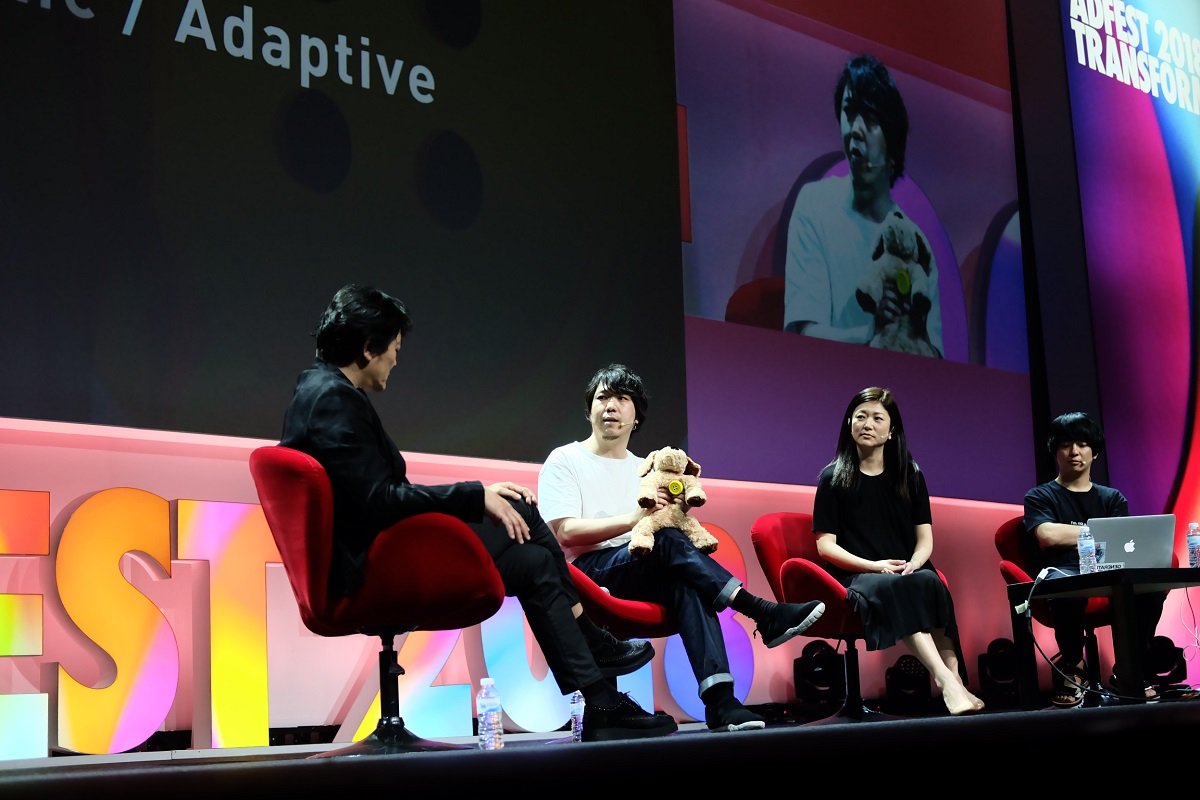
2. How it was realized
KIMURA: Did the process go smoothly from getting the idea to launching it?
SUZUKI: It was easy up until developing the prototype as we were working as a small team. But from there to actual launch was not so easy; we were inexperienced in almost everything. We faced three major challenges. The first, and the biggest challenge, was to get internal approval for investment. The second was to find a mass-producer. And the final challenge was to find sales channels.
KIMURA: How did you overcome these three hurdles?
SUZUKI: We were lucky to have many supporters. When doing planning and production work for advertising, we often work in a small team. But in the entire process from product design to production, and marketing, you need to be inclusive; you need to include many ideas from different people at each stage. Shortly after the ideation phase, we developed a prototype and presented it at SXSW in 2016. That’s where people started talking about it on social media and we made lots of headlines. We took this positive reaction back to our agency with the prototype and the business plan, to get approval from management. And it started moving forward. Embracing reactions and being inclusive of all kinds of feedback from different people and nurturing them is what sets a positive chain reaction towards winning new supporters and taking you to the next stage.
ONO: Getting lots of media coverage was very helpful, too. It actually connected us to the company that would develop and manufacture Pechat. I knew that it would take a while to gain our agency’s agreement for investment. But I didn’t want to miss the momentum. So, I decided to start the development before the final approval from management.
KIMURA: Really? You took it on yourself? Was that possible? I mean…the money and everything?
ONO: It was adrenaline! The development up to the stage right before mass production amounted to 100,000 US dollars, maybe? But I thought “if the worst comes to the worst, I’ll pay for it.” And I think this determination moved the team, including the development team and manufacturer. They gave me their full support.
KIMURA: One hundred thousand dollars? Wow! That’s real commitment! “I will pay if you won’t.” Were you really ready pay that much if you didn’t get approval?
ONO: I was half serious. The other half of me believed and hoped that the agency would pay for it.
SUZUKI: It’s really this kind of determination that moves people. Ultimately, I think it was Naoki’s conviction that won the hearts of our senior management for approval.
KIMURA: So that’s how you got approval from the company for mass-production. But how did you develop sales channels?
SUZUKI: That really was another challenge for us, because obviously, we had never done it before. So we were completely in the dark, and that led us to think about crowd-funding, which was beginning to take off in Japan at the time. We took Pechat to a crowd-funding site for pre-sales. The result was huge beyond our imagination. We collected about 140,000 dollars, from 3,000 backers.
ONO: At the time, the media and sales channels were looking into crowd-funding sites for new products. So, creating a buzz there had a great PR effect. Inquiries started flooding in, and we were gaining PR and distribution opportunities at the same time.
KIMURA: I see. So you got the media and the general public involved at an early stage by creating a prototype, then the distribution channels by generating word-of-mouth around the crowd-funding initiative. Good job! You leveraged the positive reactions to break through the challenges of mass-production and distribution channel development. That’s great!
ONO: Yes. We were very lucky. Pechat sold out on the very day it was launched. We really made it big.
3. The difference between advertising and product development
KIMURA: And that brings us to my last question, which is: What’s the biggest difference between advertising and product development?
ONO: Good question! One thing I can say is that with product development, you should keep talking. With advertising, everything ends with the creation and delivery of your work, but with products, creation is the start of everything. And this is what I’m trying to do with Pechat in particular. We’ve continued to upgrade and update since launch. For example, we found that people often purchased it as a baby gift. But you couldn’t enjoy it when the baby can’t talk. So we developed “baby mode.” Working with experts, we created a new function, which helps soothe fussy babies with comforting music and also works as a crying detector.
SUZUKI: We created another function in the app to accept requests from users. Many users also said that they wanted to use the product for English learning. And that’s how we came to launch another app for kids to study English called “Pechat English.”
ONO: Right. And those updates made through conversations with users led to PR and generated more media coverage of the new functions. Product growth and marketing go hand in hand.
KIMURA: I see. So you’re “being inclusive” and you “keep talking” with users even after delivering the product. That’s how you offer more to talk about, and continue to win more fans. Bringing the internal stakeholders, developer, distribution channels and users together to this one idea, making it happen, and continuing to evolve—that’s a very modern approach. Now I understand how it’s possible to combine product design and communication.
Thank you.
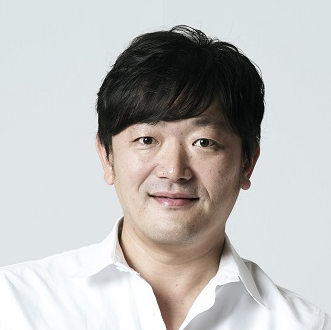
He established Hakuhodo Kettle, a one-of-a-kind creative agency, in 2006. Truly innovative ideas can come from anywhere. For this reason, everyone at his company is familiar with every field of communication. Bubbling up and serving his clients new ideas, his goal is for Hakuhodo Kettle to set the whole world aboil.
In addition to his role as Kettle’s Co-CEO, Kentaro has since April 2017 also served as Hakuhodo’s APAC Co-CCO. This has led him to start traveling all around Asia.
Kentaro has won more than 100 awards including 8 grand prizes in various international advertising festivals such as Cannes Lions, D&AD Awards, The One Show, Clio Awards, London International Awards, ADC Annual Awards, ADFEST, AD STARS, and Spikes Asia with work for Sony, Google, Shiseido, Toyota, Suntory, and more. He has served as a member of more than 25 jury teams, including the Promo and Titanium & Integrated juries at Cannes Lions and the Executive Jury at New York Festivals, and has been Promo & Direct jury president at ADFEST and Digital & Mobile jury president at Spikes Asia. He was an official speaker at Cannes Lions in 2013, 2014, and 2015.
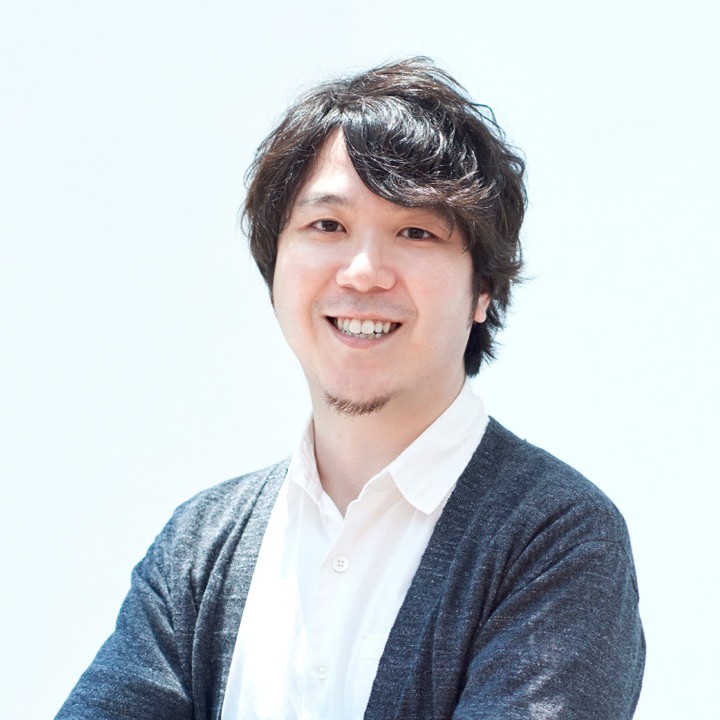
Outside of Hakuhodo, Naoki is the founder of the design studio YOY. He has held an exhibition at the Milan SaloneSatellite every year since 2012. His works have been sold worldwide including at MoMA, and have won many domestic and international awards. He has been teaching part-time at Musashino Art University since 2015.Naoki’s numerous awards include Red Dot Design Award (2017), Good Design Award Best 100 (2016, 2017), NYCxDESIGN Award (2016), Design Intelligence Award DIA Innovation (2016), Asia Pacific Interior Design Awards Silver (2015), ELLE DECOR Japan Young Japanese Design Talent Award (2014), Design Report Award (2014), SaloneSatellite Award (2014), Japan Sign Design Award Grand Prize (2014), and many others.
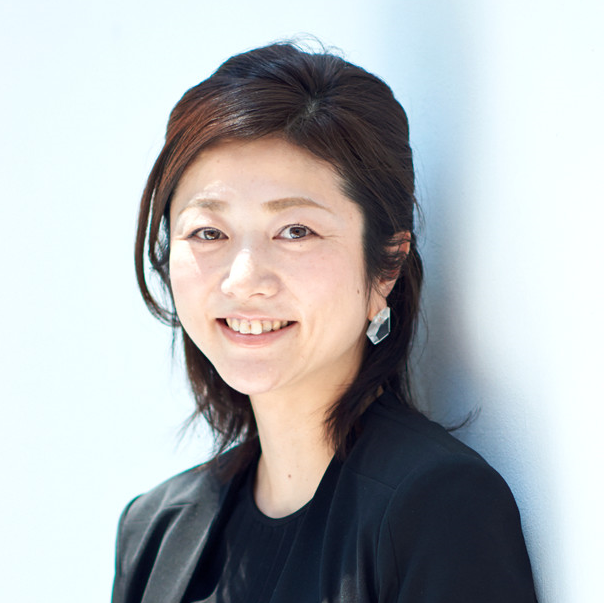
She then took a brief break from Hakuhodo to lead creative campaigns and projects for global brands as a freelance account producer at Wieden+Kennedy Tokyo in 2008. Working with multi-cultural teams who constantly challenged the traditional mass media-based Japanese way of advertising, her view on creativity was opened to a whole new dimension.
After finding a new love for digital/interactive creative, she returned once again to Hakuhodo in 2011, this time as a creative producer.
Along the journey, Ai has picked up numerous international and national awards from Cannes Lions, D&AD Awards, ADFEST, Spikes Asia, The Webby Awards, 4A Yahoo! Creative Awards, and many others.













